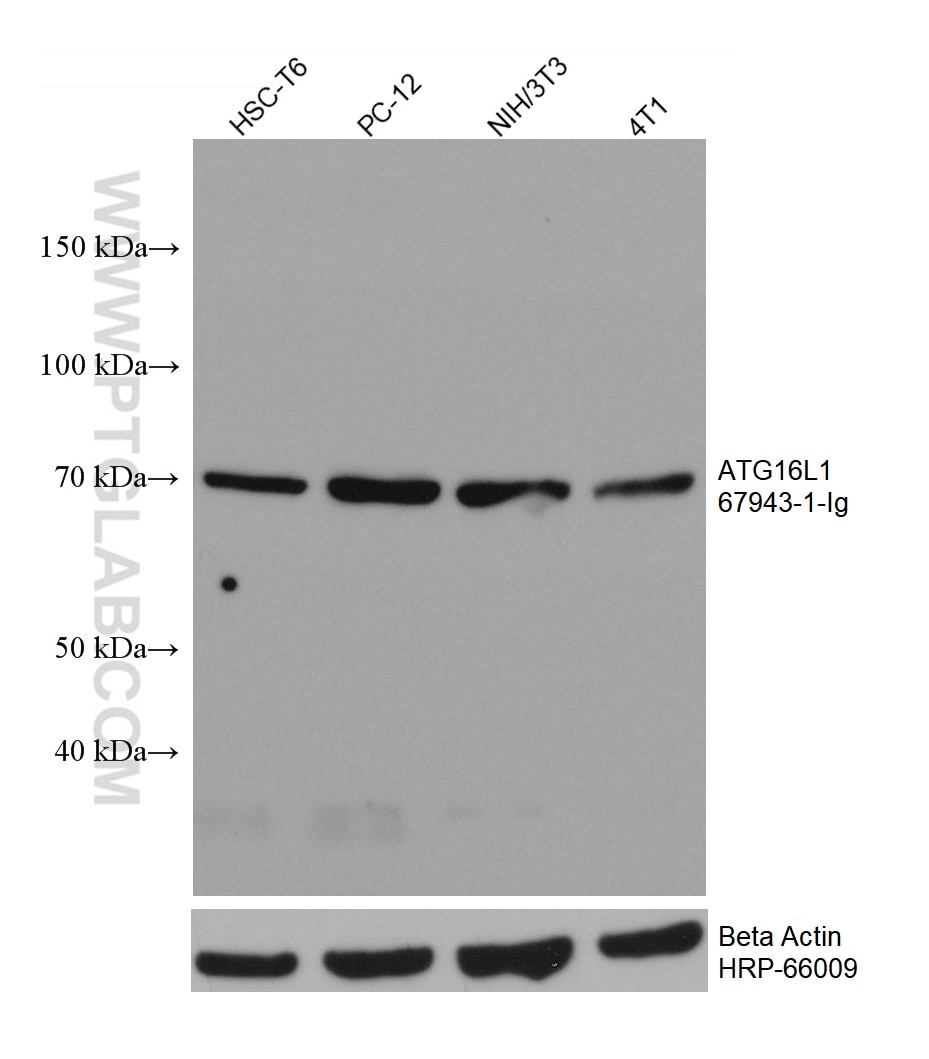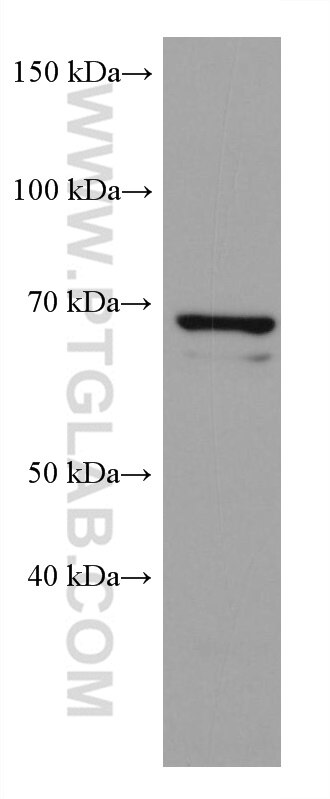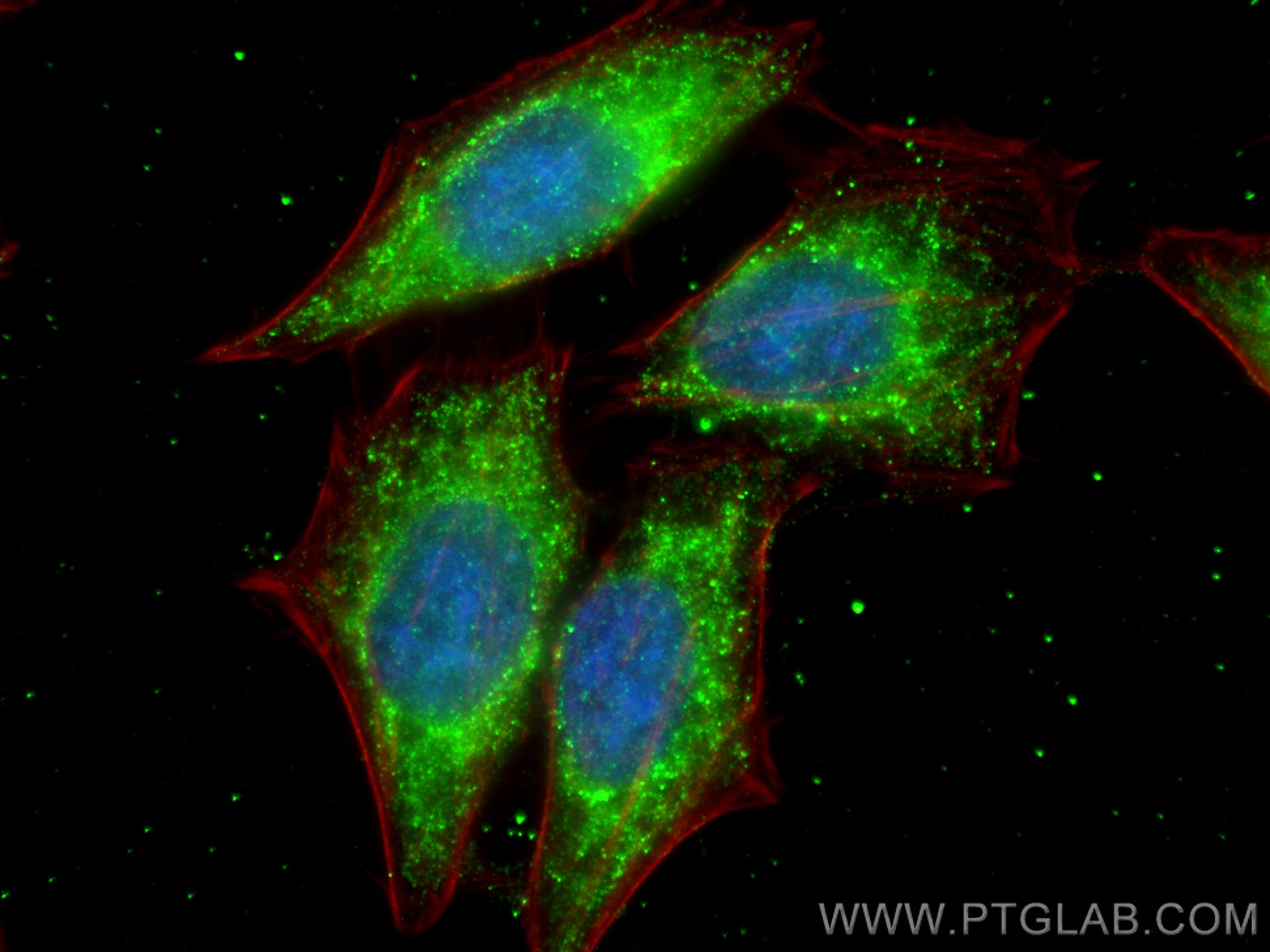Anticorps Monoclonal anti-ATG16L1
ATG16L1 Monoclonal Antibody for WB, IF/ICC, ELISA
Hôte / Isotype
Mouse / IgG1
Réactivité testée
Humain, rat, souris et plus (1)
Applications
WB, IF/ICC, IP, ELISA
Conjugaison
Non conjugué
CloneNo.
1G5G7
N° de cat : 67943-1-Ig
Synonymes
Galerie de données de validation
Applications testées
| Résultats positifs en WB | cellules HSC-T6, cellules 4T1, cellules HepG2, cellules NIH/3T3, cellules PC-12, tissu pulmonaire de rat |
| Résultats positifs en IF/ICC | cellules HepG2, |
Dilution recommandée
| Application | Dilution |
|---|---|
| Western Blot (WB) | WB : 1:1000-1:6000 |
| Immunofluorescence (IF)/ICC | IF/ICC : 1:200-1:800 |
| It is recommended that this reagent should be titrated in each testing system to obtain optimal results. | |
| Sample-dependent, check data in validation data gallery | |
Applications publiées
| WB | See 10 publications below |
| IF | See 2 publications below |
| IP | See 1 publications below |
Informations sur le produit
67943-1-Ig cible ATG16L1 dans les applications de WB, IF/ICC, IP, ELISA et montre une réactivité avec des échantillons Humain, rat, souris
| Réactivité | Humain, rat, souris |
| Réactivité citée | rat, Humain, porc |
| Hôte / Isotype | Mouse / IgG1 |
| Clonalité | Monoclonal |
| Type | Anticorps |
| Immunogène | ATG16L1 Protéine recombinante Ag14881 |
| Nom complet | ATG16 autophagy related 16-like 1 (S. cerevisiae) |
| Masse moléculaire calculée | 607 aa, 68 kDa |
| Poids moléculaire observé | 68-75 kDa |
| Numéro d’acquisition GenBank | BC000061 |
| Symbole du gène | ATG16L1 |
| Identification du gène (NCBI) | 55054 |
| Conjugaison | Non conjugué |
| Forme | Liquide |
| Méthode de purification | Purification par protéine G |
| Tampon de stockage | PBS with 0.02% sodium azide and 50% glycerol |
| Conditions de stockage | Stocker à -20°C. Stable pendant un an après l'expédition. L'aliquotage n'est pas nécessaire pour le stockage à -20oC Les 20ul contiennent 0,1% de BSA. |
Informations générales
Human ATG16L1 is a 607 amino acid protein (~68 kDa) comprising three major domains: the N‐terminal ATG5 binding domain (ATG5‐BD), the central coiled‐coil domain (CCD) and a predicted C‐terminal WD40‐domain. ATG16L1α and β (Atg16L1α, 63 kDa; and Atg16L1β, 71 kDa) are the major isoforms expressed in intestinal epithelium and macrophages , and all isoforms encode exon 9, which contains Thr 300. Atg16L1 mediates the cellular degradative process of autophagy and is considered a critical regulator of inflammation based on its genetic association with inflammatory bowel disease. ATG16L1 has been implicated in Crohn's disease. (PMID: 24553140, PMID: 22740627,PMID: 28685931)
Protocole
| Product Specific Protocols | |
|---|---|
| WB protocol for ATG16L1 antibody 67943-1-Ig | Download protocol |
| IF protocol for ATG16L1 antibody 67943-1-Ig | Download protocol |
| Standard Protocols | |
|---|---|
| Click here to view our Standard Protocols |
Publications
| Species | Application | Title |
|---|---|---|
Front Immunol Porcine cGAS-STING signaling induced autophagy inhibits STING downstream IFN and apoptosis | ||
Epileptic Disord lncRNA UCA1 induces autophagic gene expression via epigenetic regulation mediated by ATG16L1 and miR-132-3p in SH-SY5Y cells treated with retinoic acid | ||
Dev Cell V-ATPase recruitment to ER exit sites switches COPII-mediated transport to lysosomal degradation | ||
Cell Signal The hsa_circ_0002371/hsa-miR-502-5p/ATG16L1 axis modulates the survival of intracellular Mycobacterium tuberculosis and autophagy in macrophages | ||
Theranostics FUNDC1 alleviates doxorubicin-induced cardiotoxicity by restoring mitochondrial-endoplasmic reticulum contacts and blocked autophagic flux |





